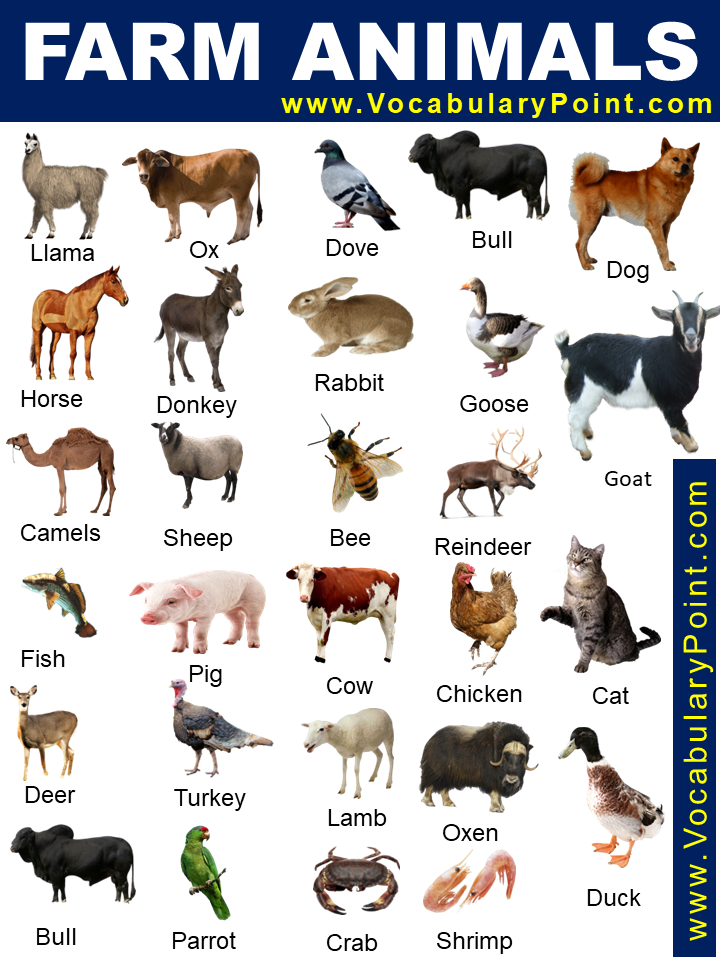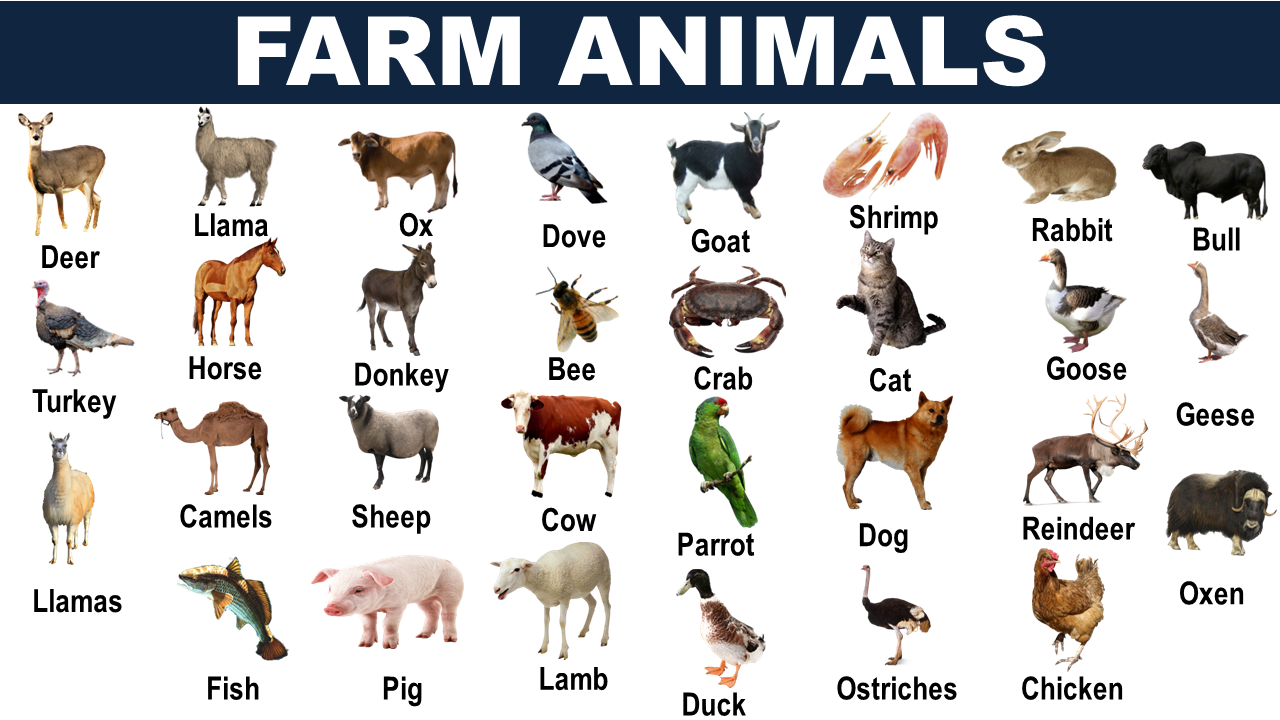Farm animals play a crucial role in human society, providing a wide range of resources such as meat, milk, and wool, as well as labor and companionship. These domesticated animals are raised in various agricultural settings for profit and sustenance, shaping the landscape of rural economies around the world. Farm animals also contribute significantly to cultural practices, diets, and economies.
List of Farm Animals
- Cow – Dairy production, large, grass-fed
- Chicken – Egg layers, meat source, domestic
- Pig – Intelligent, omnivorous, meat production
- Sheep – Wool production, herd animals, docile
- Goat – Agile, milk and meat production
- Turkey – Large bird, festive meals, feathered
- Duck – Waterfowl, eggs, meat, feathers
- Rabbit – Small, furry, breeding rapidly
- Horse – Transportation, work, competitive sports
- Donkey – Load carriers, stubborn, hardy
- Mule – Horse-donkey hybrid, strong, sturdy
- Buffalo – Milk, meat, draught power
- Llama – Fiber production, pack animals, tall
- Alpaca – Wool production, smaller than llamas
- Camel – Drought-resistant, long-distance travel, milk
- Guinea Pig – Small, pet, short-haired, social
- Bee – Pollination, honey production, stinging
- Quail – Small game bird, egg production
- Peacock – Ornamental bird, colorful, large feathers
- Ostrich – Large flightless bird, leather, feathers
- Yak – High-altitude, milk, meat, fiber
- Bison – Large, herd animal, meat production
- Partridge – Game bird, ground-nesting, meat source
- Carp – Freshwater fish, pond-raised, edible
- Catfish – Whiskered fish, bottom feeders, farmable
- Tilapia – Popular aquaculture fish, fast-growing
- Deer – Venison production, antlered, wild farms
- Elk – Large deer, meat, antler velvet
- Emu – Large bird, lean meat, oil
- Goose – Meat production, feather down, guarding
- Ferret – Small carnivore, pest control, playful
- Snail – Escargot, slow-moving, shell-bearing
- Pigeon – Meat production, racing, message carrying
- Angora Rabbit – Wool production, long-haired, docile
- Water Buffalo – Rice field plowing, milk, meat
- Coy Fish – Ornamental pond fish, colorful, peaceful
- Pheasant – Game bird, colorful plumage, wild-taste
- Swan – Waterfowl, ornamental, aggressive protectors
- Muscovy Duck – Less oily meat, brooding mother
- Guinea Fowl – Pest control, loud, gamey meat
- Zebu – Humped cattle, draught, meat production
- Chinchilla – Fur production, small, nocturnal
- Highland Cattle – Long-haired, cold-tolerant, beef production
- Jersey Cow – High-quality milk, small, docile
- Holstein Cow – Dairy production, black-and-white, large
- Hereford Cow – Beef production, red body, white face
- Angus Cow – Quality beef, hornless, black
- Brahman Cow – Heat tolerant, humped back, meat
- Ayrshire Cow – Dairy cow, red and white
- Charolais Cow – Beef cattle, white, muscular
- Dorset Sheep – Wool and meat, horned, white
- Merino Sheep – Fine wool, hardy, prized fleece
- Suffolk Sheep – Black face, meat production
- Boer Goat – Meat goat, stocky, white body
- Nubian Goat – Long-eared, milk production
- Pygmy Goat – Small, pet or meat, playful
- Landrace Pig – Large, white, floppy ears
- Berkshire Pig – Black, quality meat, heritage
- Tamworth Pig – Red hair, bacon production
- Vietnamese Potbellied Pig – Small, pet, distinct belly
- Clydesdale Horse – Draft horse, large, feathered hooves
- Arabian Horse – Endurance riding, spirited, dished face
- Thoroughbred Horse – Racing, fast, athletic
- Shire Horse – Draft, tall, powerful
- Appaloosa Horse – Spotted coat, versatile, American breed
- Belgian Horse – Strong draft horse, gentle
- Friesian Horse – Black, elegant, carriage horse
- Morgan Horse – Compact, versatile, American origin
- Quarter Horse – Short-distance racing, cow sense
- Welsh Pony – Small, children’s mount, sturdy
- Shetland Pony – Very small, children’s pony, sturdy
- Miniature Horse – Extremely small, pet, showy
- Falabella – Smallest horse breed, Argentine origin
- Gypsy Vanner – Colorful coat, draft, feathered
- Paint Horse – Colorful pattern, stock horse type
- Palomino Horse – Golden coat, riding horse
- Paso Fino – Smooth gait, riding horse
- Percheron – Draft horse, gray or black
- Tennessee Walker – Smooth gait, plantation horse
- Mustang – Wild, feral horse, sturdy
- Brangus – Beef cattle, Angus-Brahman cross
- Simmental Cow – Dual-purpose, large frame
- Limousin Cow – Beef production, golden-red
- Galloway Cow – Beef, curly coat, polled
- Scottish Highland Cow – Long horns, wavy coat
- Salers Cow – Red coat, muscular, beef
- Romagnola Cow – White, beef, Italian origin
- Marchigiana Cow – White, muscular, Italian beef
- Chianina Cow – Tall, white, Italian beef
- Aubrac Cow – Beef, hardy, French origin
- Blonde d’Aquitaine Cow – Beef, large, French origin
- Charbray Cow – Beef hybrid, Charolais-Brahman
- Gelbvieh Cow – Red, dual-purpose, German origin
- Maine-Anjou Cow – Large, red and white, dual-purpose
- Normande Cow – Dairy and beef, French breed
- Red Poll Cow – Dual-purpose, red coat
- South Devon Cow – Beef, large, gentle
- Welsh Black Cow – Beef, all black, hardy
- White Park Cow – Ancient, horned, white with spots
- Yakutian Cow – Milk, meat, Siberian origin
Explore More Animal Vocab:
Farm Animals With Their Facts
1. Cow
A staple of farm life, cows provide milk, beef, and leather. Known for their docile nature, they require grass, hay, or silage to thrive. Cows are ruminants with a complex digestive system allowing them to digest cellulose.
2. Chicken
Chickens are ubiquitous on farms for their eggs and meat. They are social birds, often housed in flocks, and can lay between 250-300 eggs per year. Chickens also serve as natural pest controllers by eating bugs.
3. Pig
Pigs are intelligent and can be trained much like dogs. On farms, they contribute pork, lard, and leather. They have an omnivorous diet and can eat leftovers, which makes them efficient for converting scraps into protein.
4. Sheep
Sheep are raised for wool, meat (lamb and mutton), and milk. They are grazing animals, ideal for managing natural landscapes. Sheep have a strong flocking instinct and can be used to study group behavior.
5. Goat
Goats are versatile farm animals known for their ability to clear brush and produce milk, meat, and mohair. Their curious and independent nature makes them excellent escape artists, requiring secure fencing.
6. Turkey
Turkeys are primarily raised for their meat, especially popular during festive seasons like Thanksgiving. They are larger than chickens and require more space and food. Turkeys are known for their distinctive gobbling sound.
7. Duck
Ducks provide eggs, meat, and down feathers. They are adaptable and can live in wetland or pasture-based systems. Ducks are also beneficial for controlling insects and weeds in a garden or farm setting.
8. Rabbit
Rabbits are raised for meat, fur, and as pets. They reproduce quickly, making them a sustainable meat source. Rabbits need a diet high in fiber and can be housed in relatively small spaces.
9. Horse
Horses on farms may be used for riding, therapy, or work. They require significant care, including grooming, feeding, and exercise. Horses are social animals and form attachments to humans and other horses.
10. Donkey
Donkeys are often used as working animals on farms, particularly for carrying loads. They have a calm temperament and are more economical to feed compared to horses, resistant to many diseases, and effective as guard animals.
11. Mule
Mules, a cross between a male donkey and a female horse, are known for their endurance and strength. They are commonly used for transport and agricultural work, combining the hardiness of donkeys with the size and speed of horses.
12. Buffalo
Water buffaloes provide milk, meat, and are also used for tilling rice fields in many parts of Asia. They enjoy wallowing in mud, which helps them keep cool and fend off parasites.
13. Llama
Llamas are used for their wool, meat, and as pack animals. They are intelligent and can learn simple tasks after a few repetitions. Llamas are also used as guard animals for sheep and goats.
14. Alpaca
Alpacas are primarily raised for their soft and luxurious wool. They are smaller than llamas and have a more timid temperament. Alpaca fiber is hypoallergenic and comes in various natural colors.
15. Camel
Camels are vital to life in arid regions, providing transportation, milk, and meat. They have a unique ability to go for weeks without water and can carry large loads over long distances.
16. Guinea Pig
In some cultures, guinea pigs are kept for meat, while in others, they are popular as pets. They are social creatures that thrive in groups and communicate through various vocalizations.
17. Bee
Bees are critical for pollination, making them essential for successful crop yields. Honeybees produce honey, beeswax, royal jelly, and propolis, all of which are harvested for various uses.
18. Quail
Quails are small birds raised for their eggs and meat. They mature quickly and can begin laying eggs at six weeks of age. Quail eggs are considered a delicacy and are rich in nutrients.
19. Peacock
Known for their spectacular tail feathers, peacocks are often kept for ornamental purposes. The males display their plumage to attract females. They can be noisy and require space to roam.
20. Ostrich
Ostriches are the world’s largest birds and are farmed primarily for their meat, which is lean and low in cholesterol. They also produce large eggs and unique leather valued in high-end fashion.
21. Yak
Yaks are adapted to high altitudes and are used for their milk, meat, and wool. They are sturdy animals with a docile nature and can navigate rocky, mountainous terrains efficiently.
22. Bison
Once nearly extinct, bison are now farmed for their lean meat, which is richer in protein and lower in fat and cholesterol than beef. They are hardy animals, capable of surviving harsh winters.
23. Partridge
Partridges are ground-nesting birds raised for sport hunting and gourmet food. They are more robust than quail and can be found in grassland habitats where they feed on seeds and insects.
24. Carp
Carp are freshwater fish cultivated in managed aquatic farms. Known for their adaptability, they are an important food source worldwide, providing low-fat protein.
25. Catfish
Catfish are prized for their mild, versatile flesh and are often raised in freshwater ponds. They grow quickly and have a high tolerance for varying water conditions.
26. Tilapia
Tilapia is one of the most farmed fish due to its fast growth, adaptability, and mild-tasting flesh. It’s an excellent source of protein and is commonly cultivated in warmer waters.
27. Deer
Farmed mainly for venison, deer are also valued for their antlers, which are used in traditional medicine and as ornamental pieces. Deer farming requires large enclosures to accommodate their need for space and natural behavior.
28. Elk
Elk are raised for meat, leather, and antlers. They are larger than deer and require extensive grazing land. Elk meat is highly prized for its flavor and nutritional value.
29. Emu
Emus are raised for their meat, oil, and leather. The oil is used in cosmetics and pharmaceuticals due to its anti-inflammatory properties. Emus are hardy birds that tolerate a range of climates.
30. Goose
Geese are raised for meat, feathers, and as guard animals due to their territorial nature. They can be very vocal and aggressive, especially during the breeding season.

